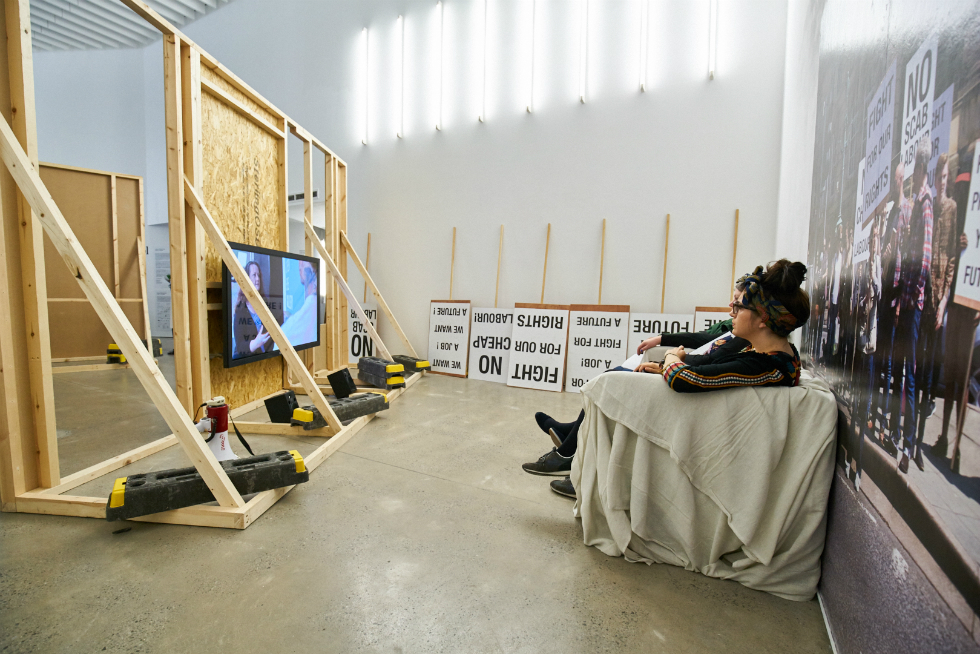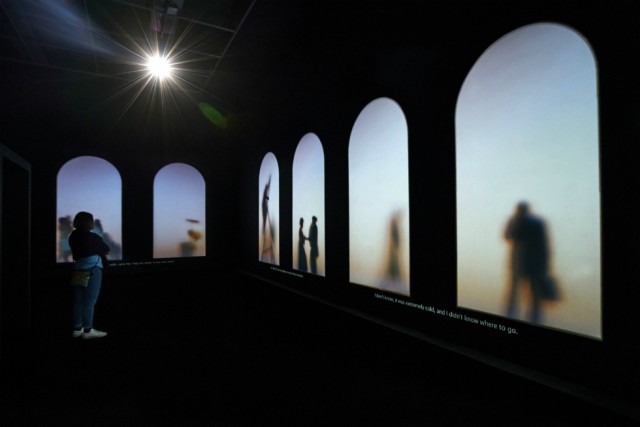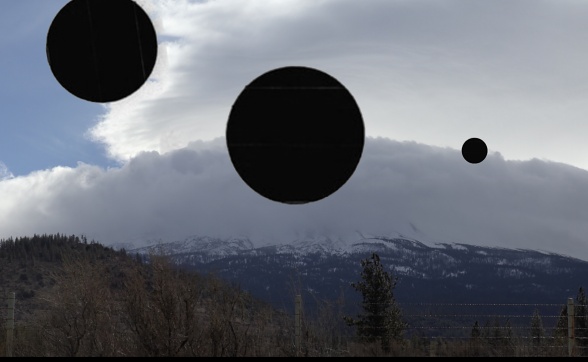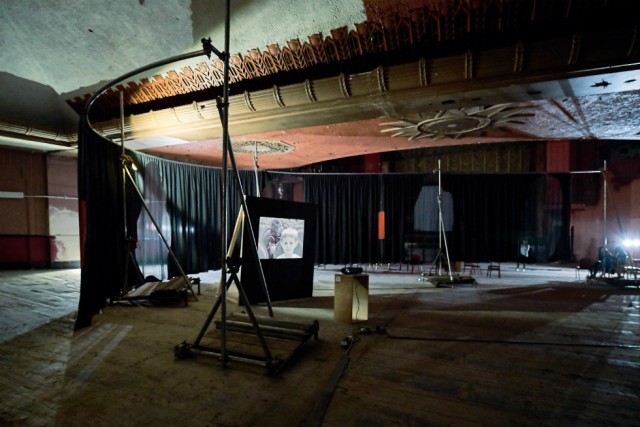“Nervously looking forward”: Liverpool Biennial’s Flashback Episode — Reviewed

Toying with the past whilst tied to a painful present: Maja Lorkowska reviews one of Liverpool Biennial’s six episodes and finds war veterans, celestial beings and young protesters…
If art’s role is to challenge rigid definitions, Liverpool Biennial’s sporadic format this year doesn’t disappoint. Sharing the omnipresent theme of Time Travel and broken into six smaller “episodes”, including one called Flashback, Biennial 2016 has presented works which might toy with the past, but hold painful relevance in the present context.
It’s the Flashback episode that has held my attention more than any other; beginning with FACT, who are presenting a large ground floor exhibition of Krzysztof Wodiczko (below). The fruit of the Polish artist’s 50-year career has been squeezed into Gallery One, organised chronologically around a dark, grey-coloured space. Wodiczko became particularly popular in the 1980s with large-scale video projections on monuments and buildings, animating public spaces with the aim of exposing the reality of those marginalised from society.
Wodiczko’s primary concern with Flashback is crystallised in the most literal sense, namely his subjects’ techniques of remembering. Post-Traumatic Stress Disorder (PTSD) is characterised by frequent vivid flashbacks, triggered by specific sensory stimuli. To make it all more relatable to an audience largely unfamiliar with the disorder, Wodiczko designed the War Veteran Helmet (2015), a device fitted with a screen closely resembling a virtual reality gadget, enabling the wearer to momentarily experience the fractured view of veterans affected by trauma.

Similarly, The Tijuana Projection (2001) shows another one of Wodiczko’s headsets in use, this time giving a voice to the women who work in cheap-labour factories; recounting their experiences by speaking directly to a camera installed within the headset, which were then projected onto the façade of El Centro Cultural. The ingenious placement of the projection in Gallery One, onto a wall high above the viewers’ heads, means that we are forced to look up at the victim; their suffering honoured by our stance. FACT’s exhibition is a thorough exploration of remembrance, through both the artist’s established position and his emotionally-charged oeuvre. It is especially jolting considering the recent Chilcot Inquiry and 2013 Savar building collapse: these are the very human results, made visible, of decisions made by government and big business.
Next up, Cain’s Brewery, which has a pleasing “found and dusted” aesthetic (now part of the Biennial tradition). Which means that the cavernous warehouse may have been taken over by international artists and their artworks, but in such a non-invasive manner that their presence almost doesn’t make a difference. Another literal flashback happens, coarse in its simplicity, which flirts with Liverpool’s past days of industrial glory.

Inside, Yin-Ju Chen’s Extrastellar Evaluations ((2016), above) takes us on a bizarre trip back (or forward?) to the lost land of the Lemuria. In her films, Chen punctuates mountainous landscape scenery with abstract, reflective cube-shapes and follows a blond-haired human walking through a forest. A wall installation of black outlines, resembling crop circles, doubles-up as a photographic timeline of many tragic 20th century events – the Apollo spacecraft crash and the Hiroshima bomb amongst them. Despite the sci-fi lens, it makes for poignant record of recent human history. Is the blond human a reflection of us as a species, aimlessly wandering around, destined to fall? Or perhaps it represents a higher being; attentive to its surroundings while the moment lasts? Whatever your conclusions, the film emits a mysterious magnetism, not least due to its panoramas of breathtaking mountainscapes.
Elsewhere, Fabien Giraud and Raphael Siboni’s film 1922 – The Uncomputable of The Unmanned (2016) series echoes in the grandeur of the decaying ABC Cinema. Here, the artist duo attempt to depict the history of technology, but backwards. It is as confusing as it is hypnotic, thanks to the abandoned theatre’s impenetrably dark surroundings and the intensity of the actors’ interactions. In fact, these are perhaps more successful than the piece’s original motive, as with no prior information, the narration seems largely disconnected from the imagery. The central character’s pained grimace is so raw that the piece could be watched without sound, just to admire her skill.

Before the big screen, you will happily pass through the maze of Samson Kambalu’s Nyau Cinema ((2016), above): one-minute clips made following the manifesto rule that “performance should be spontaneous and site/specific to found architecture, landscape, or object.” In a city so certain of its significance, and one in continuous transformation, Kambalu could not ask for more stimulating surroundings. In this instance, he shows a group of children a poster for the 1942 film Casablanca — the last film to be shown at the cinema — and asks them to recreate imagined scenes. Accompanied by casual nose-scratching and laughter, the clips are endearing and brief, and (visually) the closest we’ve come to an “original”, sepia-coloured flashback.
Head over to the Waterfront, and you’ll find Koki Tanaka‘s love letter to Liverpool and its residents at Open Eye Gallery (main image, top). Inspired by photographer Dave Sinclair’s 1980s photographs of a local mass protest against the government’s Youth Training initiative, the artist attempted to reignite the rebellious fire in the city’s young residents by initiating another match, accompanied by interviews with the original protesters. All too timely in relation to British austerity and raised tuition fees, the result is, however, more symbolic than spectacular.
Liverpool Biennial’s Flashback episode should perhaps work well in opening up the floor to unfiltered, diverse artistic responses to the very definition of the word: namely vivid memories, or looking back into an earlier time-frame. Yet this episode’s core meaning, and success, stems from the strength of the city’s identity. Embedded in the very walls of the Biennial venues, an infectious pride — and concern — has been visibly picked up by this year’s exhibiting artists. Despite the works being rooted in history, it seems that we are all nervously looking forward.
Maja Lorkowska
All images courtesy Rob Battersby, apart from Yin-Ju Chen’s Extrastellar Evaluations (2016), courtesy of the artist and Chi-Wen Gallery
See Liverpool Biennial 9 July-16 October 2016 — FREE
Download or pick up in print now our Biennial Fringe edition of Culture Diary! Your indispensable pocket guide to a wide range of alternative events across Liverpool, happening at the same time as Liverpool Biennial 2016 festival of contemporary art (Jul-Oct 2016)
Read Jack Roe’s “Exhilaratingly, intentionally naughty”: Liverpool Biennial’s Ancient Greece Episode — Reviewed
Read Katrina Houghton’s “Struggling to connect the dots”: Liverpool Biennial’s Chinatown Episode — Reviewed





